- Home
- /
- History
- /
- The Cardinall Family
- /
- Who was Esther Cardinall?...

As Cardinall is a fairly unusual name, I’ve followed various routes lined with people called Cardinall, who may or may not be related to mine just in case something useful pops up in a will. And sometimes it has. Sometimes, however, I’m left more confused than before I started!
On 20th April 1686, a spinster called Esther (or Hester) Cardinall wrote a will. The will gives no placenames at all – it doesn’t say where she lived, and she didn’t leave any land or properties which would have necessitated a place name being given. As it’s a Prerogative Court of Canterbury will, we don’t even have a hint as to which county she lived in, other than that it’s likely to be in the south of England somewhere. All we know is that she had a sister called Martha Cardinall, also a spinster, to whom Esther left “all that I have” except £10. And that £10 was to go to “my sister Mary Fullers son” when he comes of age. The son isn’t named. The witnesses were Theodosia Norton, Jo. Greenway, and Thomas Jenkins. And those are all the clues we have. I couldn’t find a marriage between a Mary Cardinall and someone called Fuller (given the age of the will, it’s probably fallen into the Commonwealth Gap or was entered into a parish register that’s since been lost).
Reverend Richard Cardinall
What I did manage to find though were baptisms for children of a Cardinall couple I hadn’t encountered before, other than in a London Consistory Court will. Richard Cardinall’s will was written on 6th July 1661. He was the clerk of West Hanningfield in Essex. He mentions land in Childerditch, occupied by Sigismond Glascock, which after the death of his wife Susanna was to be divided between his sons Daniel and Richard. And if Richard died under the age of 21, his portion was to be divided between the other children, not including Daniel. He left Daniel £30 for an apprenticeship, and 20 shillings for his sister Beatrix Bolton of Wakefield Westgate in Yorkshire.[1]Beatrix doesn’t offer further clues for us. She married Michael Boulton in Wakefield on 25th February 1646 (1645/6 or 1646/7 – not clear). Her name was given as “Beatrice … Continue reading The poor of West Hanningfield were to receive 6 shillings and 8d, and the remainder was to go to his wife Susanna, who was his sole executrix. The will was witnessed by Charles Hoole and Thomas Hill, and it was proved on 10th October 1661.
I looked up Richard on the Alumni Cantabrigienses database. His surname is given as “Carnall or Cardinall” and he matriculated from St John’s in 1628. His BA was 1631-2 and he received his MA in 1635. He was ordained deacon at Peterborough on 18th December 1641, and was rector of West Horndon in Essex from 1643-56, and of West Hanningfield from 1656-61, when he died.
Looking through the parish registers for the places he worked, I found the baptisms of ten children. Three of whom, Esther, Mary and Martha, are potentially the women connected to the mysterious 1686 will.

Richard and Susanna’s children
Seven children appear in the West Horndon parish register, a village that’s just a few miles south-east of Brentwood. Their entries are written in Latin, but we have:
- Daniel, born 13th July 1645, baptised 22nd July
- Susanna, born 26th June 1646, baptised 5th July
- Nathaniel, born 22nd March 1647/8, baptised 26th March 1648
- Hester, born 25th October 1649, baptised 1st November
- John, born 31st December 1650, baptised 7th January 1650/1. Died and was buried at Childerditch (a parish next door to West Horndon – the Childerditch register shows his burial on 18 Jan 1650/1 as “John Cardnall”, infant son of Richard Cardnall minister of West Horndon and Susannah his wife.)
- John, born 1st March 1652/3, baptised (but date not given)
- Joseph, born 3rd July 1655, baptised (but date not given)
Then in the West Hanningfield register, not written in Latin, we have:
- Mary, baptised 24th August 1656
- Martha, baptised 6th May 1660
- Richard, baptised 12th May 1661
On 11th January 1665/6, a child called Magdalen, daughter of Thomas Cardinall, was baptised in West Hanningfield. Thomas’ identity is a mystery to me – perhaps a cousin or brother of Richard, or was he a son of Richard’s born before the West Horndon baptisms were recorded?
West Hanningfield is about 12 miles north-east of West Horndon.

According to a transcription, although I can’t find them in the actual register, Esther and Nathaniel, children of Richard and Susanna, appear in the Little Tey register in 1649 and 1647 respectively. They must be from the same family.
The baptisms recorded in West Horndon’s register give some extra clues. I couldn’t make out the Latin, but the first four baptisms mention a Mrs Duckfield. Daniel’s baptism mentions a Mrs Folkingham as well.[2]I’ve found someone called Folkingham in South Weald, which may be relevant as South Weald is about 6 miles from West Horndon. What I found out was that the rector of Childerditch at the time was Daniel Duckfield.[3]According to Alumni Cantabrigienses, he studied at Christ’s College and received his MA 1608 and was the vicar of Childerditch from 1611 until his death. When I looked at his PCC will, it turns out that his daughter Susanna had married Richard Cardinall. So the Mrs Duckfield mentioned in those baptisms is Daniel’s wife. Daniel had three children by his first wife Susanna – Daniel 1616,[4]Presumably the Daniel Duckfield in Alumni Cantabrigienses who was “of Essex” and studied at St Catherine’s. He was a fellow from 1637-45. He was buried at St Botolph’s, … Continue reading Mary 1617 and Susanna 1619. His first wife died in 1621 and in 1624 he married a woman call Esther, by whom he had five children: Esther 1624, Nathaniel 1626, John 1627,[5]He is probably the John Duckfield “of Essex” in Alumni Cantabrigienses who studied at St Catherine’s and received his MA in 1649. He was the rector of Layston, Hertfordshire … Continue reading Samuel 1631 (died soon afterwards) and Martha in 1633. Presumably Richard and Susanna’s Cardinall’s fifth child, John, was buried in Childerditch because it was where Susanna was from. Mrs Esther Duckfield was buried in Childerditch on 13th April 1653. Daniel wrote his will three days later, and was himself buried in Childerditch on 14th June the same year.
“Mrs Cardenall, widdow of Childerditch” is mentioned in the will of John Palmer of Childerditch, written on 17 October 1677. This is presumably Susannah, Richard’s widow. Burials are rather gappy in the latter part of the 1600s in Childerditch’s register so if Susannah was buried there, she doesn’t appear in it. That might also explain why Esther’s burial is nowhere to be found either.
So it at least seems plausible that Esther Cardinall, who wrote her will in 1686, was Esther, daughter of Richard and Susanna Cardinall, born in West Horndon (or possibly in her grandfather’s home in Childerditch) in 1649. So she was 37 when she died. Her sister Martha in the will would have been 20, and Mary Fuller would have been thirty. This makes sense given that Mary Fuller’s son was under 21 in 1686. Had I come up with a cluster of Cardinall ladies with those names who were in their 70s and 80s, it wouldn’t be quite so likely!
So far, so good. But without a burial for Esther, I don’t know where she was living. Still in Essex, perhaps?
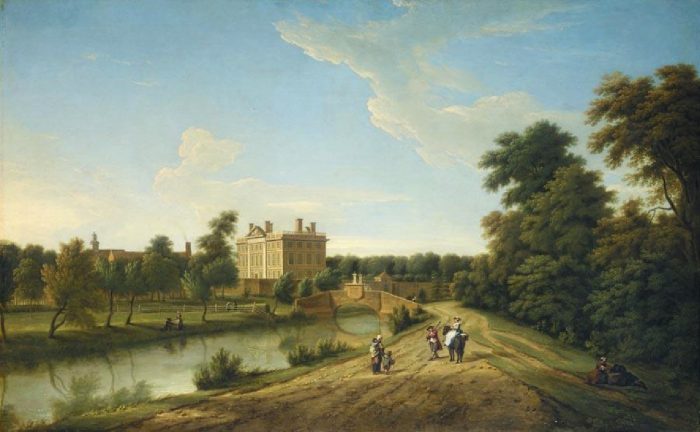
Sigismund Trafford and Theodosia Norton
Thank goodness for unusual names. In not very much time, I was able to find out quite a lot about Sigismund. His will was written in 1715, with a codicil added in 1723. Without surviving children, his will is full of his extended family which helps to reconstruct them as he was from Walthamstow and no registers have survived before the 1650s.
His parents, John Trafford and Margaret Wood, married at the church of St Peter Le Poer in the City of London in 1632. His mother was 19 at the time. The couple lived in Walthamstow and has several children, among them Sigismund (born in about 1643). Theodosia Norton is mentioned in Sigismund’s will as one of his sisters, so is presumably the same woman who was one of the witnesses of Esther Cardinall’s will. Theodosia was buried in Walthamstow on 28th January 1729/30, the register saying she was a widow, from London. Given how unusual her name is, it’s interesting to note that on the day before, a woman by the same name, “from Red Lyon Street” was buried at St Andrew’s, Holborn. Could there be two people of the same name, who died within days of each other, or are they one and the same person? More research into Theodosia hasn’t been possible. There’s a transcription for a baptism of a child called Edmund, son of Luke and Theadochia Norton, on 13th March 1670 (1669/70 or 1670/1 isn’t clear) but the location is only given as “London”, which isn’t very helpful.
Sigismund’s will mentions three other sisters – Elizabeth and Martha, who were unmarried, and Margaret Shipman. There was a brother Edmund, who appears on a memorial in St Mary the Virgin’s church in Walthamstow along with Sigismund’s mother – this was Edmund, who died 19th June 1681, aged 29. From other people mentioned in the will, it’s possible to work out how many other children John Trafford and his wife Margaret had. So here’s a list:
- Jane, who married Sir Robert Smyth, baronet, in 1653. She died in 1712 and was buried in Walthamstow (she was presumably born soon after her parents’ marriage). They had three children: Robert, James and Jane (Jane married John Pyott in 1677. Sigismund was John’s executor when he died in West Ham in 1689, calling him his uncle. His will lists five children: John, Anne, Jane, Susanna and Robert – his wife predeceased him, dying in 1684. Jane Pyott married William Cockram in 1702, and their son Sigismund Cockram was born the same year. Jane had died by the time Sigismund, her great-uncle, wrote his will in 1715 – he left Sigismund Cockram £200.)
- Sigismund, born about 1643, married twice, left no surviving children, and died in 1723.
- Theodosia, who married a man called Norton (possibly Luke), and died in January 1729/30 in London. Buried at Walthamstow.
- Ann, born about 1645, who married Fisher Dilke of St Michael’s Cornhill, a citizen of London and a skinner, in 1665. Fisher was probably born in Shustoke, Warwickshire in about 1637, the son of Fisher Dilke, gent. Fisher jnr died in about 1680, intestate, and admon was given to Sigismund. Sigismund became the guardian of their daughter Ann (born about 1670 in London, she married Clement Boehm in 1692 at St Mary Woolnoth, London). Sigismund Boehm, the eldest son of Ann and Clement, inherited Sigismund Trafford’s considerable estate, but only on the condition he took the surname Trafford.
- Margaret married Thomas Shipman in Leyton, Essex, in 1662.
- Edmund, the younger son of John and Margaret, was born in about 1652 and died in 1681.
- Elizabeth Trafford, unmarried
- Martha Trafford, unmarried
The fact that Theodosia lived in London, and Sigismund in south-west Essex, suggests that at the time Esther Cardinall wrote her will, she was living down that way herself. West Horndon is about 20 miles from Walthamstow. Looking at the other two witnesses to Esther’s will – Jo. Greenway and Thomas Jenkins – I haven’t found much, apart from the fact that one of only two Greenways in the Hearth Tax return for Essex in 1670 was a Widow Greenway living in Walthamstow. But I can’t firm up any more of a link than that.
But are we any closer to what, if anything, linked Esther to the two Trafford siblings?
Sigismund Trafford’s wives
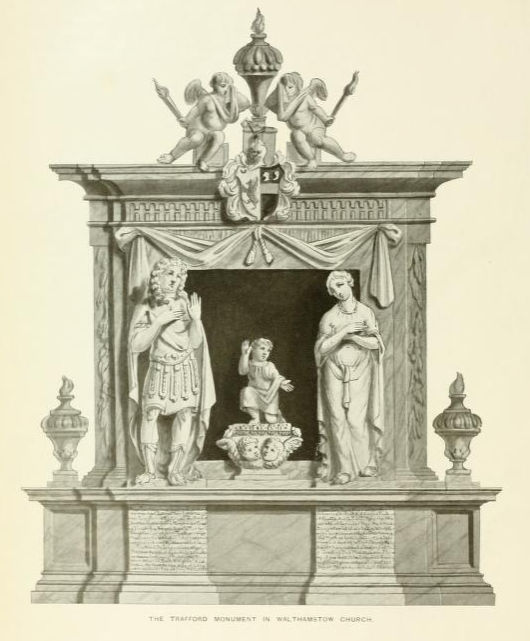
Sigismund left money for the poor of Walthamstow, on the understanding that the churchwardens looked after his memorial in the church (such an arrangement wasn’t unusual). He provided money for the maintenance of it. It must have been an expensive monument to build. It commemorates himself, wearing an oddly jarring outfit of Roman style cuirass and leather tartan with a spiffy periwig, his only child, and his first wife, Susanna.
Although the marriage itself doesn’t appear to have survived, their marriage licence has. Dated 20th January 1678/9, Sigismund Trafford of Dunton Hall, Lincolnshire, a bachelor, aged 35, was to marry Susanna Ormes of Dalston, Middlesex, a widow.[6]The licence itself says Sigismund was of “Dunhall” and that Susanna was of “Darlston”. Andrea Smith, who is researching the Traffords, has been in touch to say that she has … Continue reading The bondsman was Edmund Trafford, a gentleman of St Bride’s, London – presumably Sigismund’s brother. They intended to marry at either, All Hallows-in-the-Wall, St Bride’s or St Alban’s Wood; all churches in London.
Sigismund and Susanna’s only child, Susanna, as baptised in the church at West Ham on 13th February 1682/3, and it is presumably little Susanna who is “A child of Mr Trafford of West Ham” who was buried at Walthamstow on 14th July 1684. According to the transcription of the monument by the Walthamstow Antiquarian Society, Susanna died on 30th March 1689. The parish register for Walthamstow says that “Mrs Trayford from Bishopgate” was buried on 9th April 1689.
Susanna might be a connection to the Cardinalls. Among the East Bergholt Cardinalls, there was a Stephen Cardinall whose second wife was a widow called Mary Spencer. Although her first husband was from Essex, which is presumably where Mary lived until she married Stephen Cardinall, she was originally from Lincolnshire. Her maiden name was Fisher. Stephen and Mary had four children, among whom was Mary, who in 1584, in Warmington, Northants, married a man called Miles Orme. They had twelve children, some of whom lived in London. I expect that Susanna’s first husband was a descendantof Miles and Mary, or one of Miles’ cousins.
And there’s another possibility too. Esther Cardinall had a sister called Susanna, born in 1646. Perhaps she is the Susanna who married Sigismund Trafford? It would make sense then that Sigismund and Theodosia are connected with Esther’s will, as at the time Susanna was still alive, and Esther was Sigismund’s sister-in-law. The only fly in the ointment is that while Susanna Cardinall was born in 1646, Susanna Trafford was, according to the memorial in Walthamstow, in her 47th year, which would give her a year of birth of about 1642. It might be that it is indeed Susanna Cardinall who married first an Orme (and therefore perhaps a distant cousin – I would imagine that Richard Cardinall is related to the East Bergholt Cardinalls as the name Richard pops up in that branch) then married Sigismund and found herself memorialised in marble forever more.
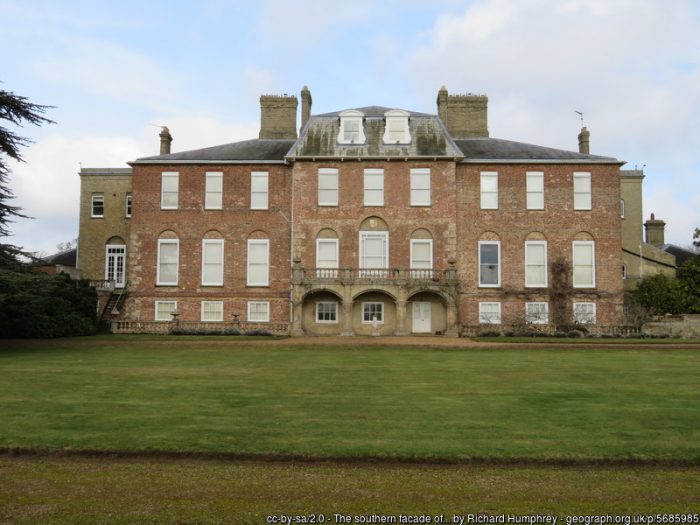
Sigismund married again in 1693, when he took another widow down the aisle. This was Dame Anne Pratt of Ryston Hall in Norfolk. Anne was the daughter of Sir Edward Monins, baronet, and she married Sir Roger Pratt. Roger, born in 1620, was admitted to the Inner Temple but travelled Europe to avoid Civil War. He returned in 1649 to the Inner Temple, but he was inspired by the buildings he’d seen on his travels and studied architecture. Among his work was Clarendon House, which when it was built in the 1660s for Lord Clarendon in London, went on to influence the future design of English country houses. He rebuilt Ryston Hall too.
Roger died in 1684, after his three sons Roger, Monins and Theodore. Anne appears to have continued living at Ryston Hall after her marriage to Sigismund (presumably between Ryston Hall, Dunton Hall and London), and Ryston passed to her first husband’s cousin. When she died in 1706, Sigismund paid for a marble tomb to be put in Ryston’s church, surmounted with a statue of Anne on top of it, dressed in fashionable style. You can see a photo on Flickr.
The Smyth baronets
The Smyth baronetage was created on 30th March 1665, and was extinct on the death of the sixth baronet, Sir George Henry Smyth, in 1852. The first baronet, Sir Robert, lived in Upton, West Ham, which is where they all lived until the fifth moved to Berechurch Hall in north-east Essex, just outside Colchester.
It was the second baronet (also the second out of four Sir Roberts) who married Sigismund’s sister Jane in 1653. According to Betham’s The Baronetage, they had three children: Robert (who in turn would become Sir Robert), James and Jane.
Jane married John Pyott of West Ham, and died aged 28 in 1684. She was buried in West Ham. It’s interesting to note that Jane’s marriage to John Pyott gives Sigismund Trafford’s family another link to the Cardinalls, although it’s a rather distant one. John Pyott’s stepmother was Anne Rowe, a daughter of Sir William Rowe. I think he’s the Sir William Rowe (1585-1668) who was the son of another Sir William Rowe (1645-96) and Anne Cheney. They can trace themselves back to Reginald Rowe (1455-1529), descending from Reginald’s son Robert. Meanwhile, Reginald’s great-granddaughter Susan (descending via Reginald’s other son, Thomas) married Richard Welby, and their daughter Dorothy (1606-1651) married James Cardinall (1603-1664) of Langham in Essex. In fact, Susan Rowe’s brother who was yet another William Rowe (are you confused yet?) married Cecily Rowe, sister of Sir William Rowe and therefore aunt of John Pyott’s stepmum.
That said, it shouldn’t really be a surprise that well-heeled families in the same area were linked. Albeit it in a rather confusing way…!
While Robert Smyth and Jane Trafford’s daughter Jane would go on to marry John Pyott, and their son Robert would go on to become the third Smyth baronet, it’s their son James who left an interesting will. The following tree from the Baronetage will come in handy…
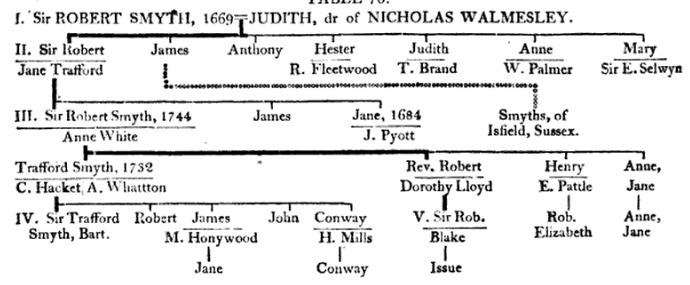
James wrote his will in 1737 and added two codicils to it before he died in 1741. As with his uncle Sigismund Trafford, James didn’t have any children so his will is full of siblings, nephews, nieces, great-nephews and great-nieces, many of whom are in the family tree presented in the Baronetage. There’s some links with Sigismund Trafford’s will – Sigismund Cockeram, James’ “nephew”, was to receive an annuity of £10. And in Sigismund Trafford’s will, he mentioned his goddaughter Sigismunda Wall. She wed a man called James Cecil of St Andrew’s, Holborn in a clandestine marriage on 16th March 1731/2, and in James Smyth’s will there’s a nephew called James Cecil, gentleman of the Middle Temple, who was one of James Smyth’s executors. They might be the same man, although I don’t know he’s related to him. Perhaps one of John and Jane Pyott’s daughters married a Cecil.
Then we have Anne White, who married James’ brother, Sir Robert. Sigismund mentions a Thomas White in his will, his “friend” of Dalston. Bearing in mind Sigismund’s first wife was from Dalston, is there a link there to Susanna Ormes, and is Anne, Sir Robert’s wife, a relative of Thomas’?
As an aside, I should mention that the Smyth baronets are an intriguing bunch in their own right. The 5th baronet, Sir Robert, married Charlotte Sophia Delaval Blake of Hanover Square, and she and their three children were painted by Reynolds. Then Sir Robert went to Paris and caused a scandal when, infused with revolutionary spirit, he renounced his title. When he died in 1802, his son Sir George Henry Smyth became the sixth and last baronet. His only child, Charlotte, was born illegitimately to Eve Elmore, who would become Smyth’s wife. Charlotte married a man called Thomas White (did he have connections with the man of the same name who cropped up in Sigismund Trafford’s will, or Anne her great-great-grandmother?) and she died of tuberculosis aged 32. One of Charlotte’s daughters herself had an illegitimate child, which was born at Sir George Henry’s home of Berechurch Hall when she was 17. It is said that Charlotte’s ghost haunts “Charlotte’s Pool”, a shell-bedecked pool her father built for her at Berechurch so that she could swim. It is derelict now, full of other people’s rubbish. Perhaps her ghost, a woman in diaphanous white, was suggested by her memorial in the church at Berechurch? It shows a woman lying on her back while above her two diaphanously clad angels – or possible an angel and Charlotte’s spirit? – drift off to the heavens. See the photo on Flickr.
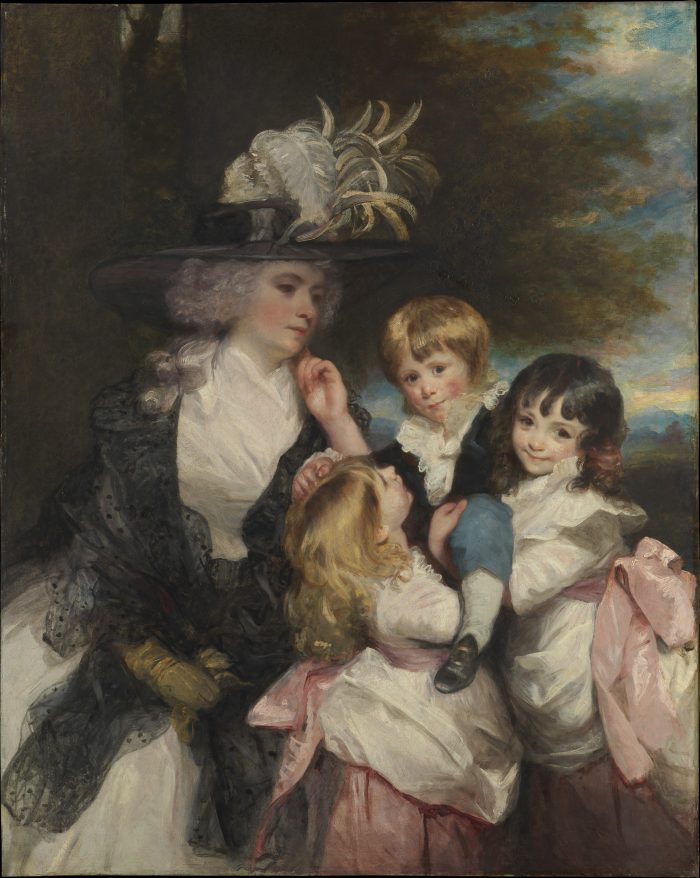
James’ will provides another link with the Cardinalls. His second codicil, dated 4th June 1741, includes a £50 annuity for the Foundling Hospital, and mentions that he’s recently bought lands in Tendring. He purchased them from Robert Halls of Colchester, including Old House Farm or lands, and Chasely Woods or Fields, and Harman’s Grove. All together it comprised of 127 acres of land, in the possession of John Marsh at a rent of £63 a year. He left it all to whoever would be his male heir among the Smyths (it would turn out to be his nephew Trafford Smyth). Chasely Woods was part of the dispute following the death of James Clarkson (son of Dorothy Cardinall – in fact, Dorothy was the granddaughter of Richard Welby and Susan Rowe mentioned above).
James left the property to his grandson James Wale (son of Clarkson’s daughter Elizabeth and her first husband, Henry Wale), and if his grandson died without issue, it was to be divided between the children of his cousin, John Cardinall. His grandson did indeed die without issue but there followed a dispute, which involved Robert Halls as he was the grandson’s guardian and also James Clarkson’s executor. He was presumably a friend or relative of James Wale’s father, who had died and his mother married again, to a surgeon called Harris Salter. Bearing in mind that Robert sold the land to James Smyth, it seems that Robert had either bought it from the Cardinalls or the dispute meant they never inherited it. Elizabeth, James Clarkson’s daughter, claimed Robert Halls had been collecting rents for properties and not giving her the money. Elizabeth claimed that Old House Lands and Chasely Woods were part of the jointure of James Clarkson’s wife, Elizabeth Beriffe.
So is it a coincidence that someone whose uncle knew at least one of the Cardinalls (and may have been married to one of them) should have bought property that had been destined for the Cardinalls yet had been subject of a dispute? It might be… but then again, perhaps it wasn’t. James Smyth was the executor of his nephew Robert Pyott of Layer-de-la-Haye, which is where William Cardinall’s daughter Elizabeth moved to. William had been in line to inherit Chasely Woods with his siblings. William was living in Alresford at the time Robert Pyott died, but there might have been someone – the Tiffins perhaps – who lived in Layer-de-la-Haye through whom the Cardinalls might have known Robert Pyott. Indeed, James Smyth owned Blind Knights in Layer-de-la-Haye too, which is where John Tiffin lived, and the Tiffins are related by marriage to the Cardinalls.
Again, it might just be coincidence, but who knows? If I’m able to get to archives and have a good rummage, it might well be the case that one day I can solve some of these questions. But for now, I don’t know what happened to any of Rev Richard Cardinall’s children, aside from what Esther put down in her will.
Footnotes
| ↑1 | Beatrix doesn’t offer further clues for us. She married Michael Boulton in Wakefield on 25th February 1646 (1645/6 or 1646/7 – not clear). Her name was given as “Beatrice Carnall”. Between 1649 and 1657 they had five sons and a daughter. I can’t find any wills associated with the Boltons, but it looks like Michael might have been a chapman in 1667, according to deeds held by the West Yorkshire History Centre. I can’t find Michael’s burial, but Beatrix Bolton, widow, was buried in Wakefield on 14th October 1676. She’s the only person with the name Carnall that I could find. Why she went to Wakefield, I don’t know, but as a chapman was a merchant or travelling salesman, he might have had business in East Anglia which led to the two of them meeting. And who knows what other relatives Beatrix and Richard Cardinall had who lived in the north? |
|---|---|
| ↑2 | I’ve found someone called Folkingham in South Weald, which may be relevant as South Weald is about 6 miles from West Horndon. |
| ↑3 | According to Alumni Cantabrigienses, he studied at Christ’s College and received his MA 1608 and was the vicar of Childerditch from 1611 until his death. |
| ↑4 | Presumably the Daniel Duckfield in Alumni Cantabrigienses who was “of Essex” and studied at St Catherine’s. He was a fellow from 1637-45. He was buried at St Botolph’s, Cambridge, on 3rd May 1645 and left a Vice Chancellor’s Court of Cambridge will. |
| ↑5 | He is probably the John Duckfield “of Essex” in Alumni Cantabrigienses who studied at St Catherine’s and received his MA in 1649. He was the rector of Layston, Hertfordshire 1663-70, and of Aspenden, Herts, from 1670 until his death in 1685. His son, Daniel, studied at Christ’s as well. He was rector of several different parishes until his death in 1702. He left a VCC will. |
| ↑6 | The licence itself says Sigismund was of “Dunhall” and that Susanna was of “Darlston”. Andrea Smith, who is researching the Traffords, has been in touch to say that she has found a possible marriage for Susanna – Robert Orme and Susanna Idell married at Canterbury on 16th April 1668 – she was aged 23, which isn’t quite right for her to be Esther’s sister. |
